ECO511 Economics for Business: Market Structures & Policy Analysis
VerifiedAdded on 2023/06/12
|15
|3631
|173
Homework Assignment
AI Summary
This assignment delves into various economic concepts within the context of business, focusing on market structures and government policies in Australia. It analyzes the impact of excise tax increases on the tobacco industry, examining supply and demand dynamics and the incidence of tax burden. Furthermore, it explores different market structures like perfect competition, monopolistic competition, and oligopoly, providing examples and equilibrium analysis. The assignment also discusses the economic rationale behind merging local government councils in Australia, highlighting economies of scale and capacity. Desklib offers a platform for students to access similar solved assignments and past papers for comprehensive study support.
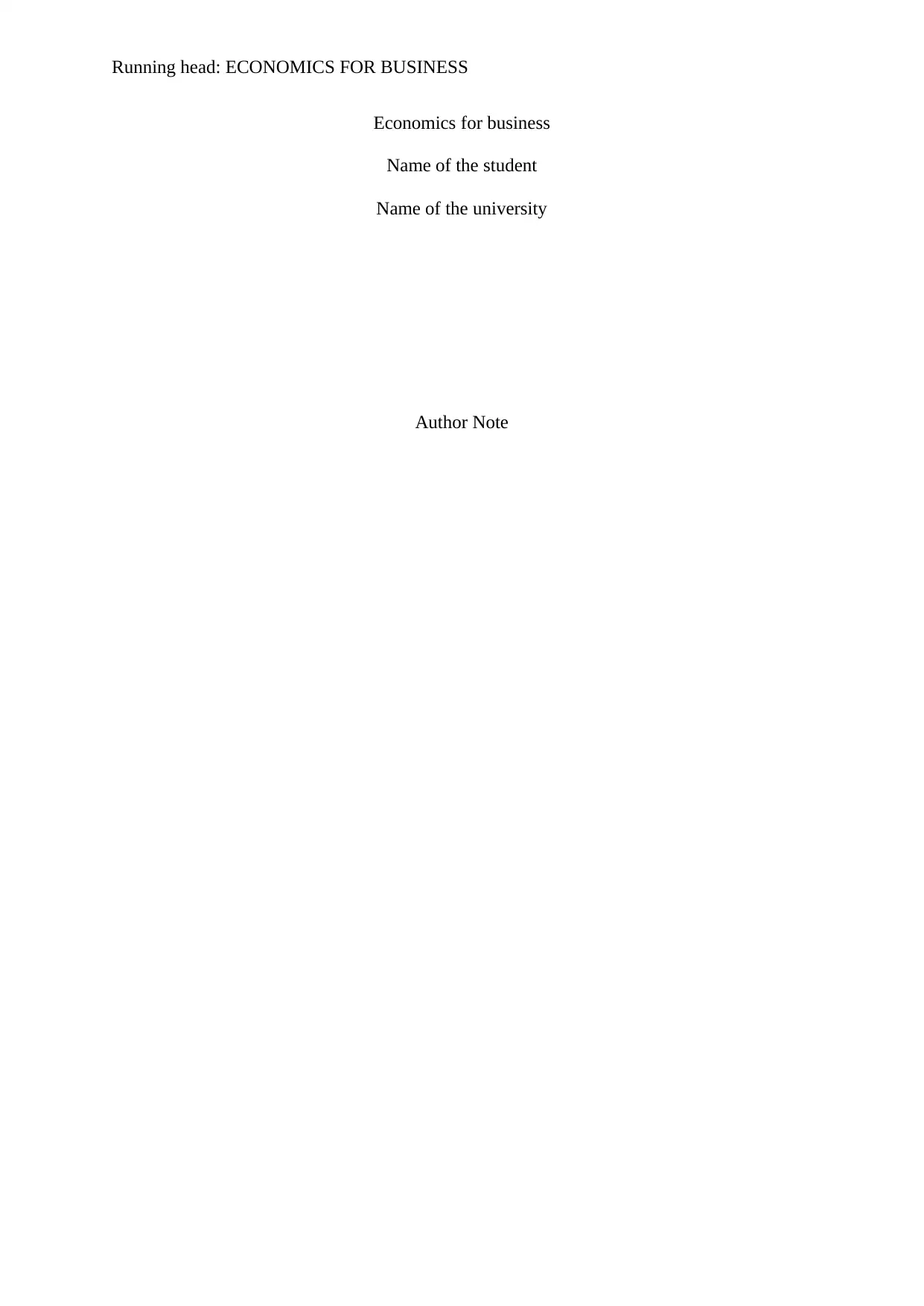
Running head: ECONOMICS FOR BUSINESS
Economics for business
Name of the student
Name of the university
Author Note
Economics for business
Name of the student
Name of the university
Author Note
Paraphrase This Document
Need a fresh take? Get an instant paraphrase of this document with our AI Paraphraser
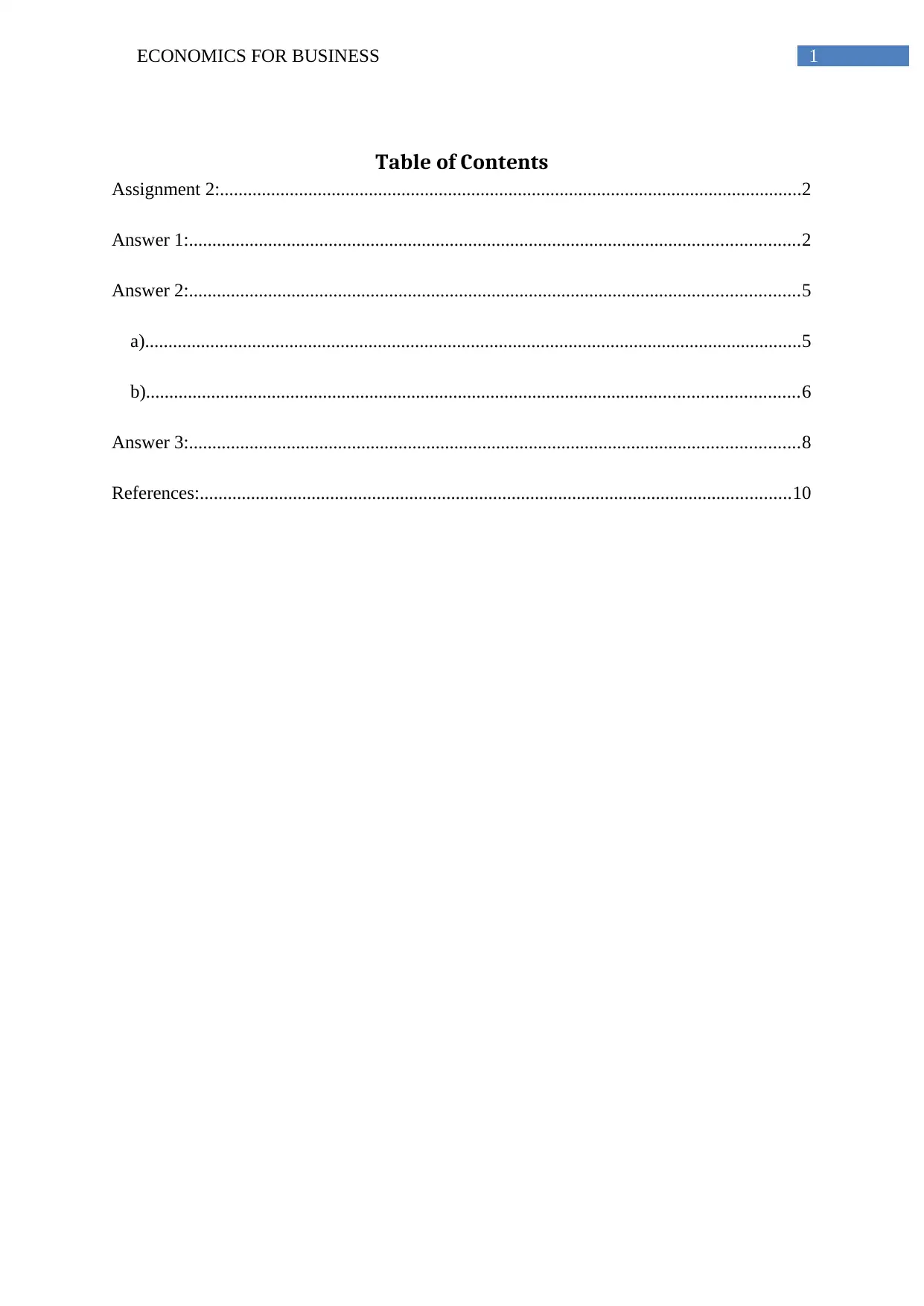
1ECONOMICS FOR BUSINESS
Table of Contents
Assignment 2:.............................................................................................................................2
Answer 1:...................................................................................................................................2
Answer 2:...................................................................................................................................5
a).............................................................................................................................................5
b)............................................................................................................................................6
Answer 3:...................................................................................................................................8
References:...............................................................................................................................10
Table of Contents
Assignment 2:.............................................................................................................................2
Answer 1:...................................................................................................................................2
Answer 2:...................................................................................................................................5
a).............................................................................................................................................5
b)............................................................................................................................................6
Answer 3:...................................................................................................................................8
References:...............................................................................................................................10
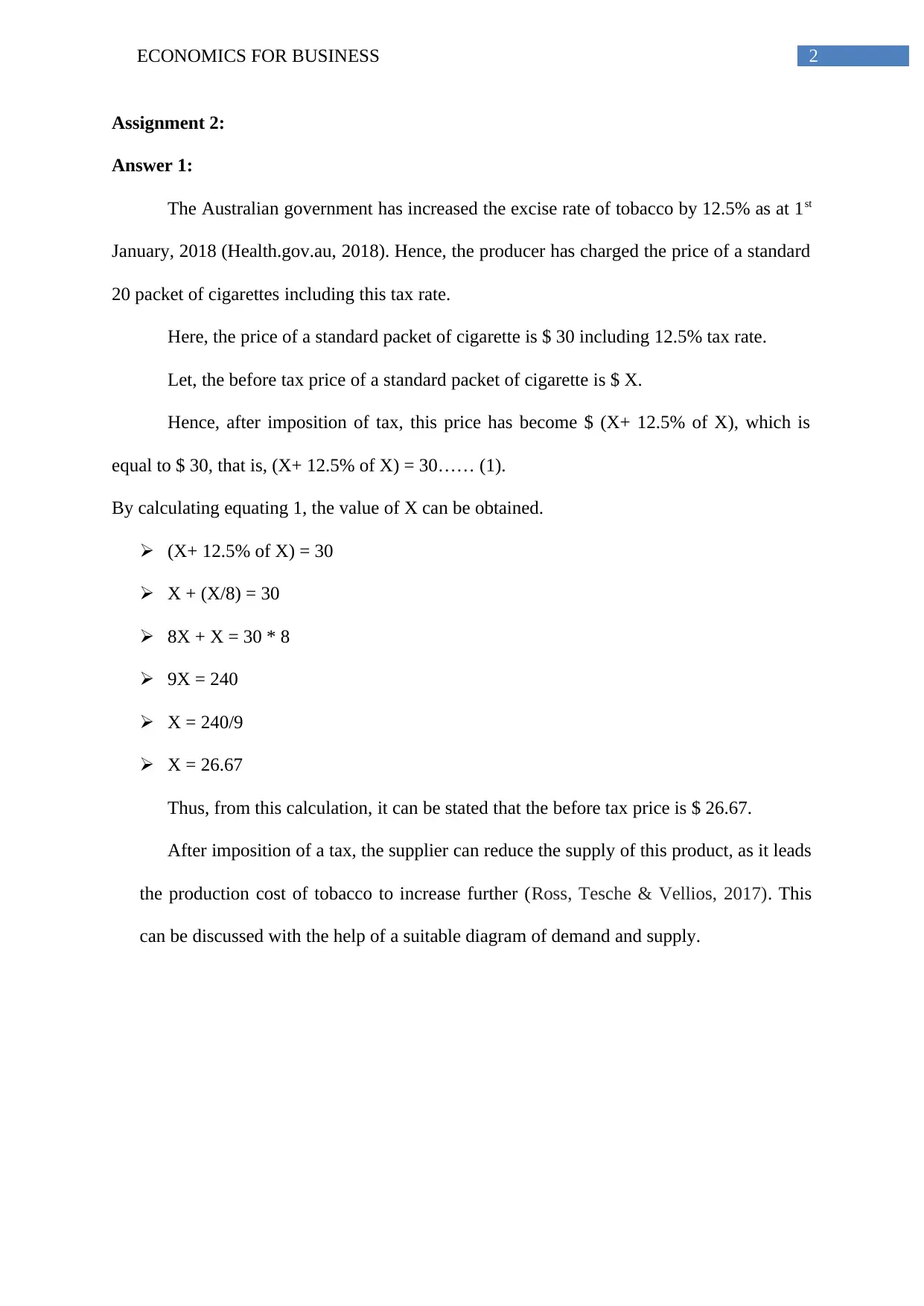
2ECONOMICS FOR BUSINESS
Assignment 2:
Answer 1:
The Australian government has increased the excise rate of tobacco by 12.5% as at 1st
January, 2018 (Health.gov.au, 2018). Hence, the producer has charged the price of a standard
20 packet of cigarettes including this tax rate.
Here, the price of a standard packet of cigarette is $ 30 including 12.5% tax rate.
Let, the before tax price of a standard packet of cigarette is $ X.
Hence, after imposition of tax, this price has become $ (X+ 12.5% of X), which is
equal to $ 30, that is, (X+ 12.5% of X) = 30…… (1).
By calculating equating 1, the value of X can be obtained.
(X+ 12.5% of X) = 30
X + (X/8) = 30
8X + X = 30 * 8
9X = 240
X = 240/9
X = 26.67
Thus, from this calculation, it can be stated that the before tax price is $ 26.67.
After imposition of a tax, the supplier can reduce the supply of this product, as it leads
the production cost of tobacco to increase further (Ross, Tesche & Vellios, 2017). This
can be discussed with the help of a suitable diagram of demand and supply.
Assignment 2:
Answer 1:
The Australian government has increased the excise rate of tobacco by 12.5% as at 1st
January, 2018 (Health.gov.au, 2018). Hence, the producer has charged the price of a standard
20 packet of cigarettes including this tax rate.
Here, the price of a standard packet of cigarette is $ 30 including 12.5% tax rate.
Let, the before tax price of a standard packet of cigarette is $ X.
Hence, after imposition of tax, this price has become $ (X+ 12.5% of X), which is
equal to $ 30, that is, (X+ 12.5% of X) = 30…… (1).
By calculating equating 1, the value of X can be obtained.
(X+ 12.5% of X) = 30
X + (X/8) = 30
8X + X = 30 * 8
9X = 240
X = 240/9
X = 26.67
Thus, from this calculation, it can be stated that the before tax price is $ 26.67.
After imposition of a tax, the supplier can reduce the supply of this product, as it leads
the production cost of tobacco to increase further (Ross, Tesche & Vellios, 2017). This
can be discussed with the help of a suitable diagram of demand and supply.
⊘ This is a preview!⊘
Do you want full access?
Subscribe today to unlock all pages.

Trusted by 1+ million students worldwide

3ECONOMICS FOR BUSINESS
Figure 1: shift in supply of tobacco
Source: (created by author)
In figure 1, the demand and supply of tobacco has been drawn. The initial supply
curve is denoted by S0 along with the initial demand curve D0. The amount of market
equilibrium can be determined by equating these two curves. In the above figure,
equilibrium level of output is Q0 and corresponding level of price is P0. However, after
imposition of tax, supplier has reduced the supply of tobacco and this in turn has shifted
the supply curve toward left, that is, from S0 to S1. Consequently, price has increased by
P0 P1 unit while the quantity supplied of tobacco has decreased by Q0 Q1 unit (Zoutman,
Gavrilova & Hopland, 2018). Thus, after imposition of tax, the cost of tobacco production
has increased consequently and to cover this excess cost, the seller has increased the price
of this concerned product.
To determine the actual taxpayer, it is essential to discuss about the impact and
incidence of tax to analyze the share of tax burden between sellers and buyers (Farrell,
2017). In this context, the tax is imposed on the seller and this in turn has increased the
cost of production of this concerned person. Consequently, the seller has increased the
price of tobacco, as it is an inelastic good. This means, after increase in price, the demand
Figure 1: shift in supply of tobacco
Source: (created by author)
In figure 1, the demand and supply of tobacco has been drawn. The initial supply
curve is denoted by S0 along with the initial demand curve D0. The amount of market
equilibrium can be determined by equating these two curves. In the above figure,
equilibrium level of output is Q0 and corresponding level of price is P0. However, after
imposition of tax, supplier has reduced the supply of tobacco and this in turn has shifted
the supply curve toward left, that is, from S0 to S1. Consequently, price has increased by
P0 P1 unit while the quantity supplied of tobacco has decreased by Q0 Q1 unit (Zoutman,
Gavrilova & Hopland, 2018). Thus, after imposition of tax, the cost of tobacco production
has increased consequently and to cover this excess cost, the seller has increased the price
of this concerned product.
To determine the actual taxpayer, it is essential to discuss about the impact and
incidence of tax to analyze the share of tax burden between sellers and buyers (Farrell,
2017). In this context, the tax is imposed on the seller and this in turn has increased the
cost of production of this concerned person. Consequently, the seller has increased the
price of tobacco, as it is an inelastic good. This means, after increase in price, the demand
Paraphrase This Document
Need a fresh take? Get an instant paraphrase of this document with our AI Paraphraser
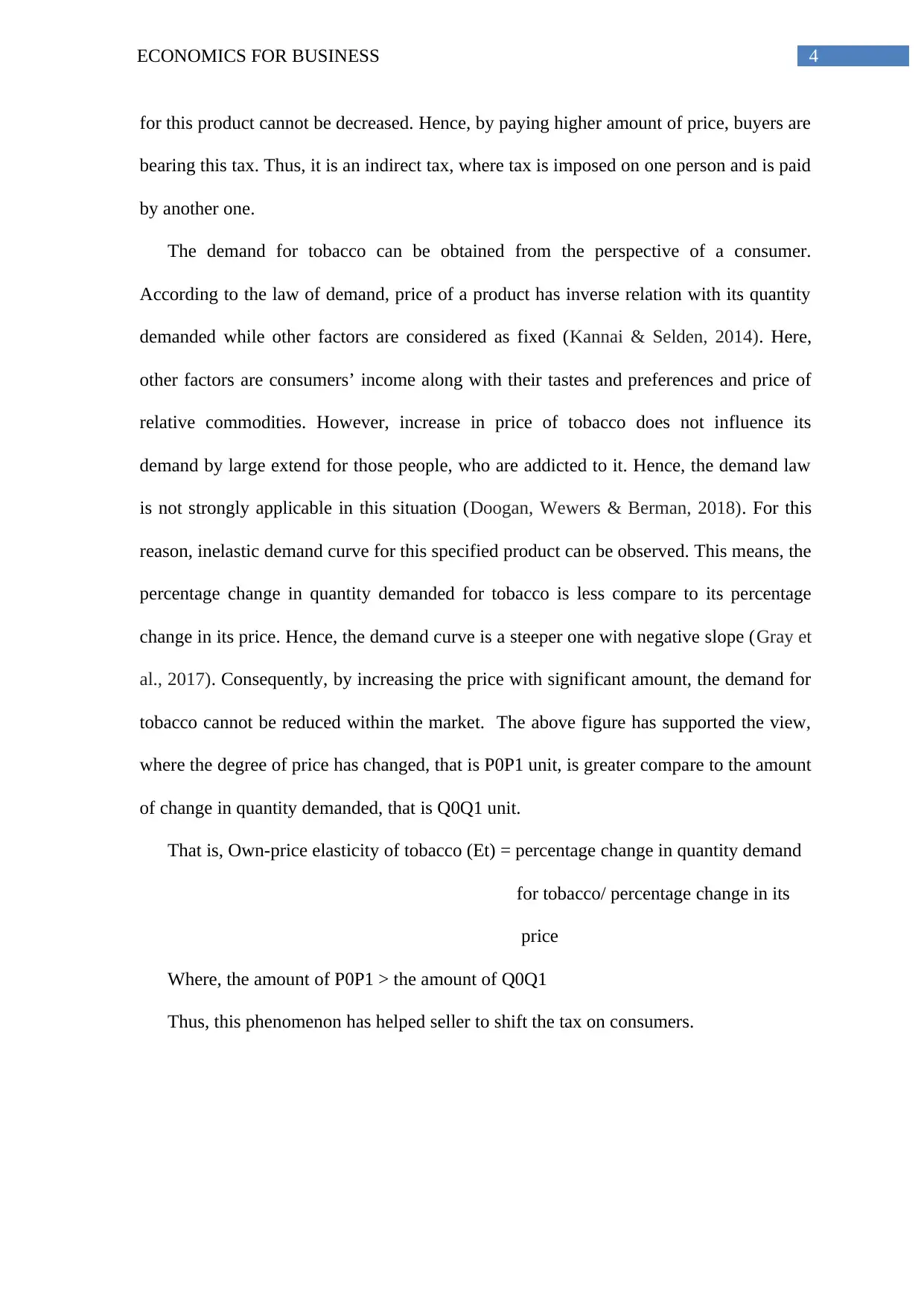
4ECONOMICS FOR BUSINESS
for this product cannot be decreased. Hence, by paying higher amount of price, buyers are
bearing this tax. Thus, it is an indirect tax, where tax is imposed on one person and is paid
by another one.
The demand for tobacco can be obtained from the perspective of a consumer.
According to the law of demand, price of a product has inverse relation with its quantity
demanded while other factors are considered as fixed (Kannai & Selden, 2014). Here,
other factors are consumers’ income along with their tastes and preferences and price of
relative commodities. However, increase in price of tobacco does not influence its
demand by large extend for those people, who are addicted to it. Hence, the demand law
is not strongly applicable in this situation (Doogan, Wewers & Berman, 2018). For this
reason, inelastic demand curve for this specified product can be observed. This means, the
percentage change in quantity demanded for tobacco is less compare to its percentage
change in its price. Hence, the demand curve is a steeper one with negative slope (Gray et
al., 2017). Consequently, by increasing the price with significant amount, the demand for
tobacco cannot be reduced within the market. The above figure has supported the view,
where the degree of price has changed, that is P0P1 unit, is greater compare to the amount
of change in quantity demanded, that is Q0Q1 unit.
That is, Own-price elasticity of tobacco (Et) = percentage change in quantity demand
for tobacco/ percentage change in its
price
Where, the amount of P0P1 > the amount of Q0Q1
Thus, this phenomenon has helped seller to shift the tax on consumers.
for this product cannot be decreased. Hence, by paying higher amount of price, buyers are
bearing this tax. Thus, it is an indirect tax, where tax is imposed on one person and is paid
by another one.
The demand for tobacco can be obtained from the perspective of a consumer.
According to the law of demand, price of a product has inverse relation with its quantity
demanded while other factors are considered as fixed (Kannai & Selden, 2014). Here,
other factors are consumers’ income along with their tastes and preferences and price of
relative commodities. However, increase in price of tobacco does not influence its
demand by large extend for those people, who are addicted to it. Hence, the demand law
is not strongly applicable in this situation (Doogan, Wewers & Berman, 2018). For this
reason, inelastic demand curve for this specified product can be observed. This means, the
percentage change in quantity demanded for tobacco is less compare to its percentage
change in its price. Hence, the demand curve is a steeper one with negative slope (Gray et
al., 2017). Consequently, by increasing the price with significant amount, the demand for
tobacco cannot be reduced within the market. The above figure has supported the view,
where the degree of price has changed, that is P0P1 unit, is greater compare to the amount
of change in quantity demanded, that is Q0Q1 unit.
That is, Own-price elasticity of tobacco (Et) = percentage change in quantity demand
for tobacco/ percentage change in its
price
Where, the amount of P0P1 > the amount of Q0Q1
Thus, this phenomenon has helped seller to shift the tax on consumers.

5ECONOMICS FOR BUSINESS
Answer 2:
a)
Q TC ATC(TC/
Q)
TFC AFC(TFC =
50/Q)
TVC (TC-
TFC)
AVC
(TVC/Q)
MC
0 50 50 50 50 0 0 50
1 100 100 50 50 50 50 50
2 140 70 50 25 90 45 40
3 170 56.666666
67
50 16.66666667 120 40 30
4 190 47.5 50 12.5 140 35 20
5 210 42 50 10 160 32 20
6 230 38.333333
33
50 8.333333333 180 30 20
7 260 37.142857
14
50 7.142857143 210 30 30
8 300 37.5 50 6.25 250 31.25 40
9 350 38.888888
89
50 5.555555556 300 33.333333
33
50
10 410 41 50 5 360 36 60
Table 1: ATC, AFC, AVC, MC of a perfectly competitive firm
In table 1, Q and TC denote different levels of output and total cost, respectively.
With the help of those data, average total costs (ATC), average fixed costs (AFC), average
variable costs (AVC) and marginal costs (MC) have been determined. For different level of
output, ATC can be obtained by dividing total cost with its corresponding output (de Jong et
al., 2017). Moreover, the firm has bear 50 amount of total cost, when output has remained nil.
This implies that the total fixed cost of this firm is 50 units, which is fixed for each level of
output. Hence, by dividing total fixed cost with the number of output of each level, average
fixed cost can be obtained. Total variable costs, on the other side, can be determined as well.
The difference between total cost and total fixed cost of each output level has provided the
total variable cost (Garmon, 2017). This cost is required to divide with the number of output
by which, average variable cost can be obtained. Marginal cost represents the difference
between total costs when one unit of extra output has been produced.
Answer 2:
a)
Q TC ATC(TC/
Q)
TFC AFC(TFC =
50/Q)
TVC (TC-
TFC)
AVC
(TVC/Q)
MC
0 50 50 50 50 0 0 50
1 100 100 50 50 50 50 50
2 140 70 50 25 90 45 40
3 170 56.666666
67
50 16.66666667 120 40 30
4 190 47.5 50 12.5 140 35 20
5 210 42 50 10 160 32 20
6 230 38.333333
33
50 8.333333333 180 30 20
7 260 37.142857
14
50 7.142857143 210 30 30
8 300 37.5 50 6.25 250 31.25 40
9 350 38.888888
89
50 5.555555556 300 33.333333
33
50
10 410 41 50 5 360 36 60
Table 1: ATC, AFC, AVC, MC of a perfectly competitive firm
In table 1, Q and TC denote different levels of output and total cost, respectively.
With the help of those data, average total costs (ATC), average fixed costs (AFC), average
variable costs (AVC) and marginal costs (MC) have been determined. For different level of
output, ATC can be obtained by dividing total cost with its corresponding output (de Jong et
al., 2017). Moreover, the firm has bear 50 amount of total cost, when output has remained nil.
This implies that the total fixed cost of this firm is 50 units, which is fixed for each level of
output. Hence, by dividing total fixed cost with the number of output of each level, average
fixed cost can be obtained. Total variable costs, on the other side, can be determined as well.
The difference between total cost and total fixed cost of each output level has provided the
total variable cost (Garmon, 2017). This cost is required to divide with the number of output
by which, average variable cost can be obtained. Marginal cost represents the difference
between total costs when one unit of extra output has been produced.
⊘ This is a preview!⊘
Do you want full access?
Subscribe today to unlock all pages.

Trusted by 1+ million students worldwide
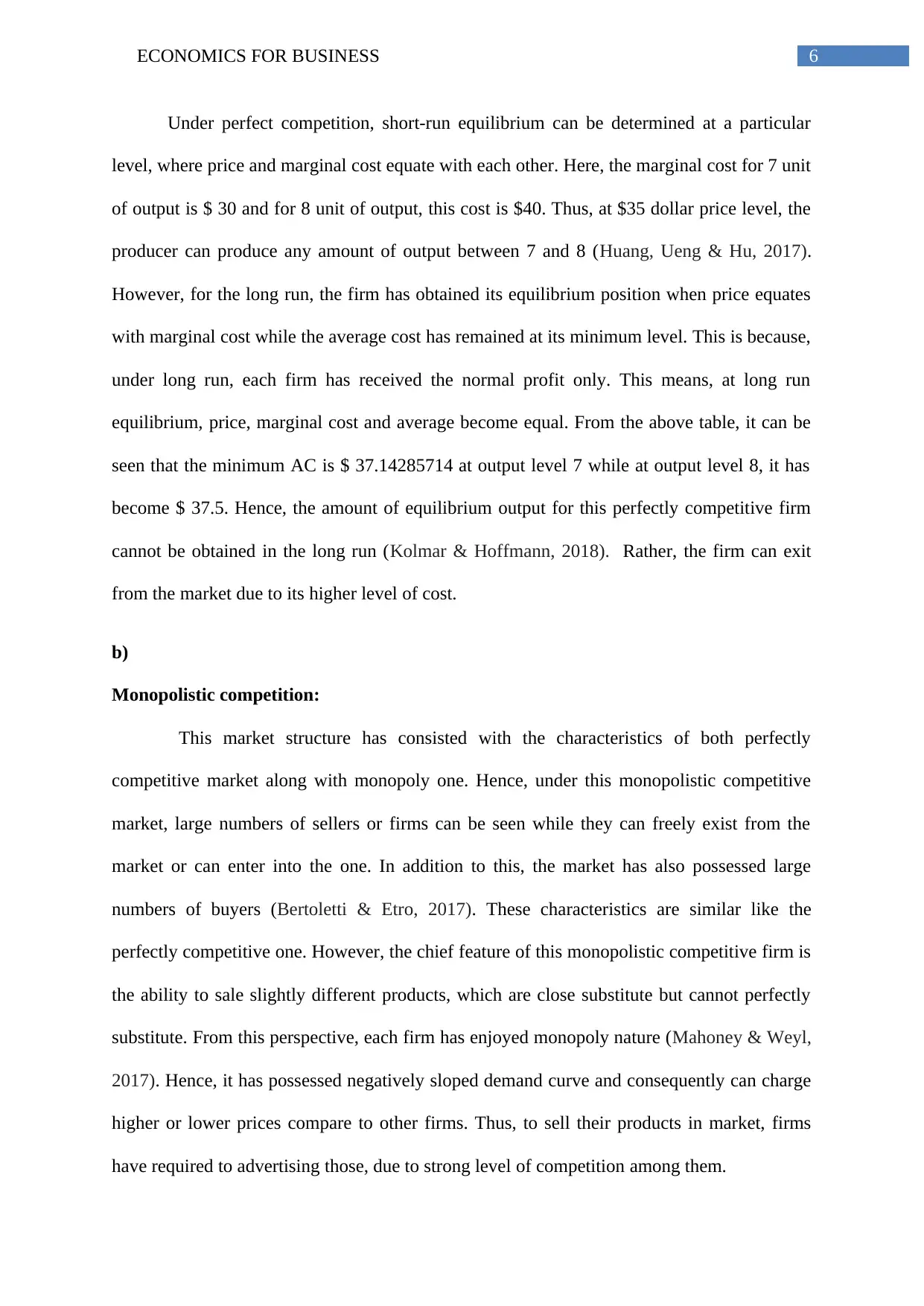
6ECONOMICS FOR BUSINESS
Under perfect competition, short-run equilibrium can be determined at a particular
level, where price and marginal cost equate with each other. Here, the marginal cost for 7 unit
of output is $ 30 and for 8 unit of output, this cost is $40. Thus, at $35 dollar price level, the
producer can produce any amount of output between 7 and 8 (Huang, Ueng & Hu, 2017).
However, for the long run, the firm has obtained its equilibrium position when price equates
with marginal cost while the average cost has remained at its minimum level. This is because,
under long run, each firm has received the normal profit only. This means, at long run
equilibrium, price, marginal cost and average become equal. From the above table, it can be
seen that the minimum AC is $ 37.14285714 at output level 7 while at output level 8, it has
become $ 37.5. Hence, the amount of equilibrium output for this perfectly competitive firm
cannot be obtained in the long run (Kolmar & Hoffmann, 2018). Rather, the firm can exit
from the market due to its higher level of cost.
b)
Monopolistic competition:
This market structure has consisted with the characteristics of both perfectly
competitive market along with monopoly one. Hence, under this monopolistic competitive
market, large numbers of sellers or firms can be seen while they can freely exist from the
market or can enter into the one. In addition to this, the market has also possessed large
numbers of buyers (Bertoletti & Etro, 2017). These characteristics are similar like the
perfectly competitive one. However, the chief feature of this monopolistic competitive firm is
the ability to sale slightly different products, which are close substitute but cannot perfectly
substitute. From this perspective, each firm has enjoyed monopoly nature (Mahoney & Weyl,
2017). Hence, it has possessed negatively sloped demand curve and consequently can charge
higher or lower prices compare to other firms. Thus, to sell their products in market, firms
have required to advertising those, due to strong level of competition among them.
Under perfect competition, short-run equilibrium can be determined at a particular
level, where price and marginal cost equate with each other. Here, the marginal cost for 7 unit
of output is $ 30 and for 8 unit of output, this cost is $40. Thus, at $35 dollar price level, the
producer can produce any amount of output between 7 and 8 (Huang, Ueng & Hu, 2017).
However, for the long run, the firm has obtained its equilibrium position when price equates
with marginal cost while the average cost has remained at its minimum level. This is because,
under long run, each firm has received the normal profit only. This means, at long run
equilibrium, price, marginal cost and average become equal. From the above table, it can be
seen that the minimum AC is $ 37.14285714 at output level 7 while at output level 8, it has
become $ 37.5. Hence, the amount of equilibrium output for this perfectly competitive firm
cannot be obtained in the long run (Kolmar & Hoffmann, 2018). Rather, the firm can exit
from the market due to its higher level of cost.
b)
Monopolistic competition:
This market structure has consisted with the characteristics of both perfectly
competitive market along with monopoly one. Hence, under this monopolistic competitive
market, large numbers of sellers or firms can be seen while they can freely exist from the
market or can enter into the one. In addition to this, the market has also possessed large
numbers of buyers (Bertoletti & Etro, 2017). These characteristics are similar like the
perfectly competitive one. However, the chief feature of this monopolistic competitive firm is
the ability to sale slightly different products, which are close substitute but cannot perfectly
substitute. From this perspective, each firm has enjoyed monopoly nature (Mahoney & Weyl,
2017). Hence, it has possessed negatively sloped demand curve and consequently can charge
higher or lower prices compare to other firms. Thus, to sell their products in market, firms
have required to advertising those, due to strong level of competition among them.
Paraphrase This Document
Need a fresh take? Get an instant paraphrase of this document with our AI Paraphraser
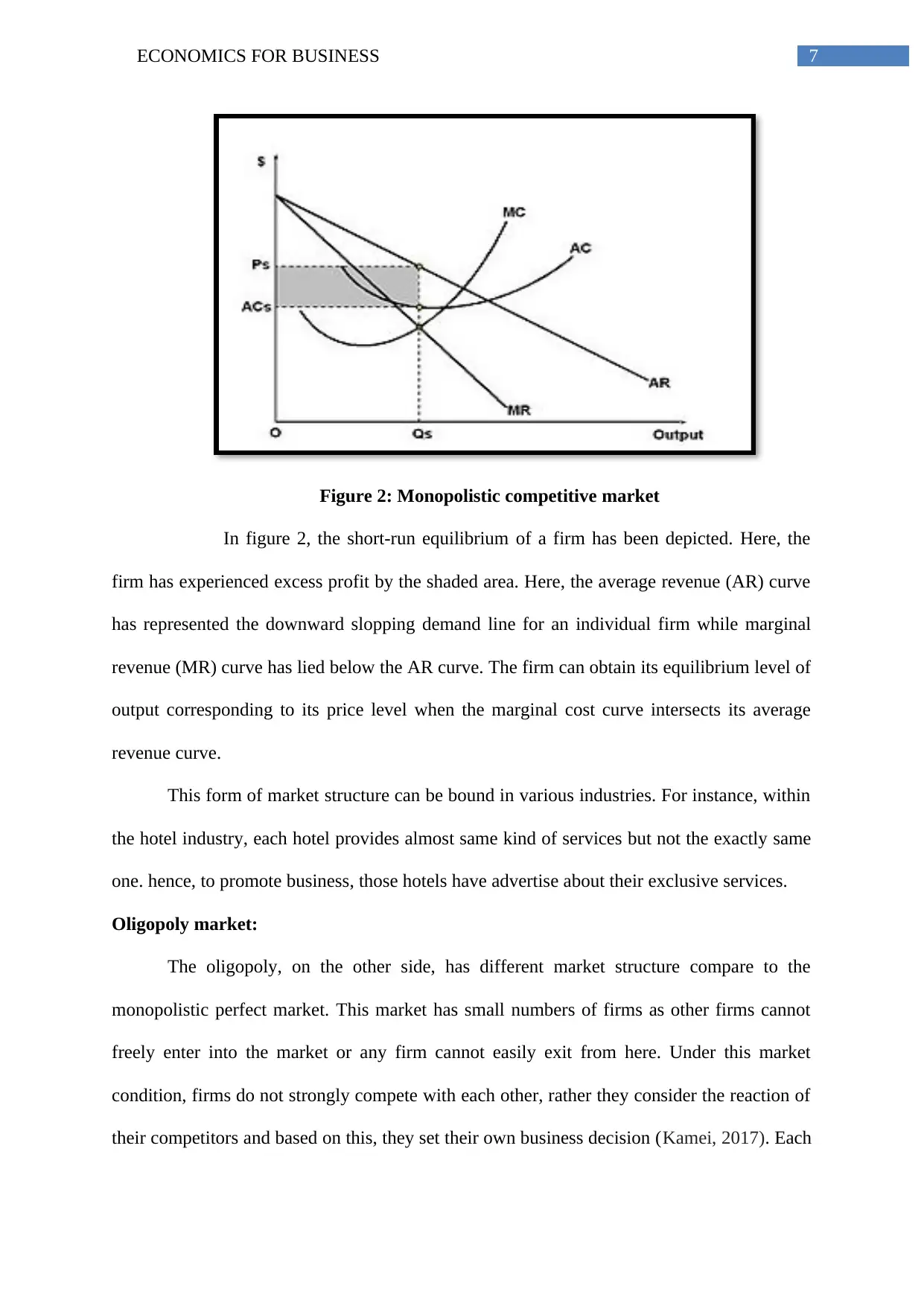
7ECONOMICS FOR BUSINESS
Figure 2: Monopolistic competitive market
In figure 2, the short-run equilibrium of a firm has been depicted. Here, the
firm has experienced excess profit by the shaded area. Here, the average revenue (AR) curve
has represented the downward slopping demand line for an individual firm while marginal
revenue (MR) curve has lied below the AR curve. The firm can obtain its equilibrium level of
output corresponding to its price level when the marginal cost curve intersects its average
revenue curve.
This form of market structure can be bound in various industries. For instance, within
the hotel industry, each hotel provides almost same kind of services but not the exactly same
one. hence, to promote business, those hotels have advertise about their exclusive services.
Oligopoly market:
The oligopoly, on the other side, has different market structure compare to the
monopolistic perfect market. This market has small numbers of firms as other firms cannot
freely enter into the market or any firm cannot easily exit from here. Under this market
condition, firms do not strongly compete with each other, rather they consider the reaction of
their competitors and based on this, they set their own business decision (Kamei, 2017). Each
Figure 2: Monopolistic competitive market
In figure 2, the short-run equilibrium of a firm has been depicted. Here, the
firm has experienced excess profit by the shaded area. Here, the average revenue (AR) curve
has represented the downward slopping demand line for an individual firm while marginal
revenue (MR) curve has lied below the AR curve. The firm can obtain its equilibrium level of
output corresponding to its price level when the marginal cost curve intersects its average
revenue curve.
This form of market structure can be bound in various industries. For instance, within
the hotel industry, each hotel provides almost same kind of services but not the exactly same
one. hence, to promote business, those hotels have advertise about their exclusive services.
Oligopoly market:
The oligopoly, on the other side, has different market structure compare to the
monopolistic perfect market. This market has small numbers of firms as other firms cannot
freely enter into the market or any firm cannot easily exit from here. Under this market
condition, firms do not strongly compete with each other, rather they consider the reaction of
their competitors and based on this, they set their own business decision (Kamei, 2017). Each

8ECONOMICS FOR BUSINESS
firm, within its market strategy, has considered two chief decisions regarding competition and
prices.
In Australia, banking sector has experienced this kind of market structure, where four
large banks have operated their business, viz., Commonwealth Bank of Australia, Australian
and New Zealand Banking Group, Westpac and the National Australian Bank (Bakir, 2017).
Answer 3:
The economic rationale for merging local government councils in some states of
Australia can be described with the help of some economical concepts(Li, Cui & Lu, 2018).
For instance, economies of scale, the capacity of local government, economies of scope along
with administrative and compliance costs can be described over here.
Economies of scale: Under the concept of economies of scale, production cost per unit of
output has decreased when total output has increased simultaneously (Baumers, Dickens,
Tuck & Hague, 2016). This is considered as the chief factor behind mergeing. Within the
concept of optimal size of local governments, economies of scale represent a decline in the
cost per person based on a particular amount of service, while service related population has
increased. Hence, the larger unit of jurisdiction can decrease per capita costs related to
service provision, significantly (Blesse & Baskaran, 2016). In general, economies of scale are
chiefly depended on the technological nature related to production system.
firm, within its market strategy, has considered two chief decisions regarding competition and
prices.
In Australia, banking sector has experienced this kind of market structure, where four
large banks have operated their business, viz., Commonwealth Bank of Australia, Australian
and New Zealand Banking Group, Westpac and the National Australian Bank (Bakir, 2017).
Answer 3:
The economic rationale for merging local government councils in some states of
Australia can be described with the help of some economical concepts(Li, Cui & Lu, 2018).
For instance, economies of scale, the capacity of local government, economies of scope along
with administrative and compliance costs can be described over here.
Economies of scale: Under the concept of economies of scale, production cost per unit of
output has decreased when total output has increased simultaneously (Baumers, Dickens,
Tuck & Hague, 2016). This is considered as the chief factor behind mergeing. Within the
concept of optimal size of local governments, economies of scale represent a decline in the
cost per person based on a particular amount of service, while service related population has
increased. Hence, the larger unit of jurisdiction can decrease per capita costs related to
service provision, significantly (Blesse & Baskaran, 2016). In general, economies of scale are
chiefly depended on the technological nature related to production system.
⊘ This is a preview!⊘
Do you want full access?
Subscribe today to unlock all pages.

Trusted by 1+ million students worldwide
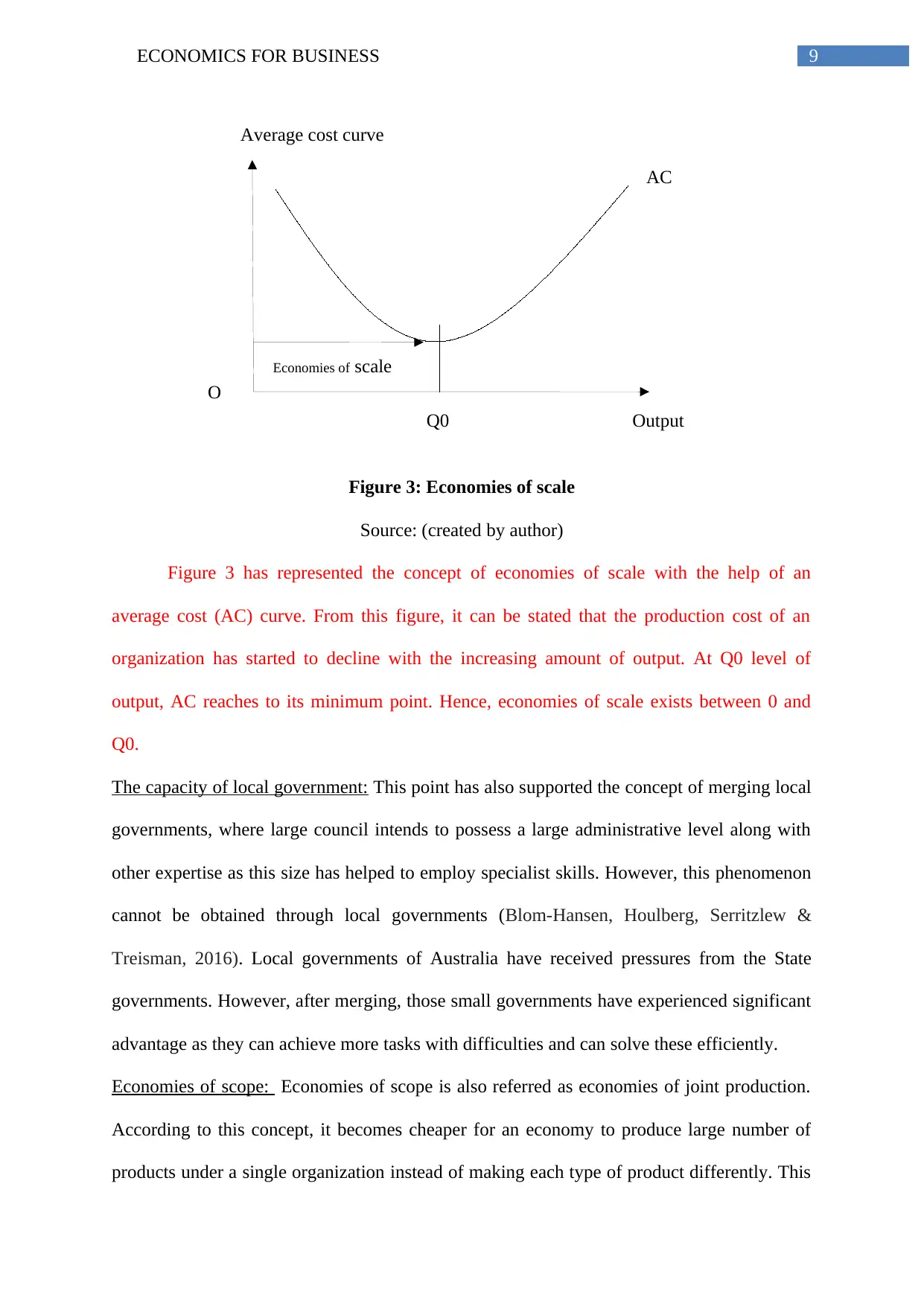
9ECONOMICS FOR BUSINESS
Average cost curve
O
Output
AC
Q0
Economies of scale
Figure 3: Economies of scale
Source: (created by author)
Figure 3 has represented the concept of economies of scale with the help of an
average cost (AC) curve. From this figure, it can be stated that the production cost of an
organization has started to decline with the increasing amount of output. At Q0 level of
output, AC reaches to its minimum point. Hence, economies of scale exists between 0 and
Q0.
The capacity of local government: This point has also supported the concept of merging local
governments, where large council intends to possess a large administrative level along with
other expertise as this size has helped to employ specialist skills. However, this phenomenon
cannot be obtained through local governments (Blom-Hansen, Houlberg, Serritzlew &
Treisman, 2016). Local governments of Australia have received pressures from the State
governments. However, after merging, those small governments have experienced significant
advantage as they can achieve more tasks with difficulties and can solve these efficiently.
Economies of scope: Economies of scope is also referred as economies of joint production.
According to this concept, it becomes cheaper for an economy to produce large number of
products under a single organization instead of making each type of product differently. This
Average cost curve
O
Output
AC
Q0
Economies of scale
Figure 3: Economies of scale
Source: (created by author)
Figure 3 has represented the concept of economies of scale with the help of an
average cost (AC) curve. From this figure, it can be stated that the production cost of an
organization has started to decline with the increasing amount of output. At Q0 level of
output, AC reaches to its minimum point. Hence, economies of scale exists between 0 and
Q0.
The capacity of local government: This point has also supported the concept of merging local
governments, where large council intends to possess a large administrative level along with
other expertise as this size has helped to employ specialist skills. However, this phenomenon
cannot be obtained through local governments (Blom-Hansen, Houlberg, Serritzlew &
Treisman, 2016). Local governments of Australia have received pressures from the State
governments. However, after merging, those small governments have experienced significant
advantage as they can achieve more tasks with difficulties and can solve these efficiently.
Economies of scope: Economies of scope is also referred as economies of joint production.
According to this concept, it becomes cheaper for an economy to produce large number of
products under a single organization instead of making each type of product differently. This
Paraphrase This Document
Need a fresh take? Get an instant paraphrase of this document with our AI Paraphraser
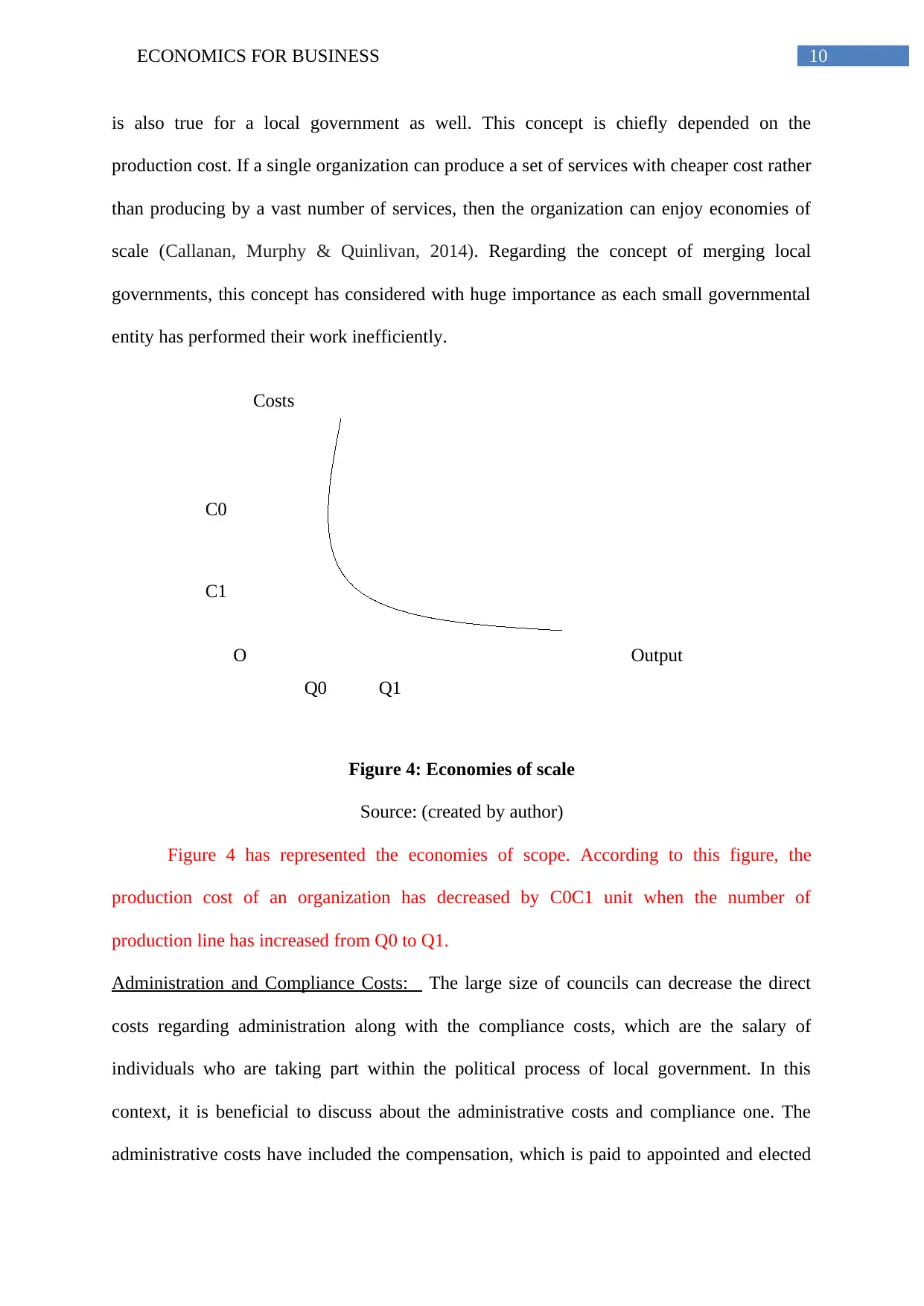
10ECONOMICS FOR BUSINESS
Costs
OutputO
C0
C1
Q0 Q1
is also true for a local government as well. This concept is chiefly depended on the
production cost. If a single organization can produce a set of services with cheaper cost rather
than producing by a vast number of services, then the organization can enjoy economies of
scale (Callanan, Murphy & Quinlivan, 2014). Regarding the concept of merging local
governments, this concept has considered with huge importance as each small governmental
entity has performed their work inefficiently.
Figure 4: Economies of scale
Source: (created by author)
Figure 4 has represented the economies of scope. According to this figure, the
production cost of an organization has decreased by C0C1 unit when the number of
production line has increased from Q0 to Q1.
Administration and Compliance Costs: The large size of councils can decrease the direct
costs regarding administration along with the compliance costs, which are the salary of
individuals who are taking part within the political process of local government. In this
context, it is beneficial to discuss about the administrative costs and compliance one. The
administrative costs have included the compensation, which is paid to appointed and elected
Costs
OutputO
C0
C1
Q0 Q1
is also true for a local government as well. This concept is chiefly depended on the
production cost. If a single organization can produce a set of services with cheaper cost rather
than producing by a vast number of services, then the organization can enjoy economies of
scale (Callanan, Murphy & Quinlivan, 2014). Regarding the concept of merging local
governments, this concept has considered with huge importance as each small governmental
entity has performed their work inefficiently.
Figure 4: Economies of scale
Source: (created by author)
Figure 4 has represented the economies of scope. According to this figure, the
production cost of an organization has decreased by C0C1 unit when the number of
production line has increased from Q0 to Q1.
Administration and Compliance Costs: The large size of councils can decrease the direct
costs regarding administration along with the compliance costs, which are the salary of
individuals who are taking part within the political process of local government. In this
context, it is beneficial to discuss about the administrative costs and compliance one. The
administrative costs have included the compensation, which is paid to appointed and elected

11ECONOMICS FOR BUSINESS
staffs and officials, who are needed to support those officials (LOIS-GONZÁLEZ &
AYMERICH-CANO, 2018). On the other side, compliance costs incorporate the costs, which
are incurred by voters of local governments to obtain information about issues and candidate
positions. These costs also include time cost and potential cash for registering an opinion
through participating in meeting, hearing and voting and so on.
staffs and officials, who are needed to support those officials (LOIS-GONZÁLEZ &
AYMERICH-CANO, 2018). On the other side, compliance costs incorporate the costs, which
are incurred by voters of local governments to obtain information about issues and candidate
positions. These costs also include time cost and potential cash for registering an opinion
through participating in meeting, hearing and voting and so on.
⊘ This is a preview!⊘
Do you want full access?
Subscribe today to unlock all pages.

Trusted by 1+ million students worldwide
1 out of 15
Related Documents
Your All-in-One AI-Powered Toolkit for Academic Success.
+13062052269
info@desklib.com
Available 24*7 on WhatsApp / Email
![[object Object]](/_next/static/media/star-bottom.7253800d.svg)
Unlock your academic potential
Copyright © 2020–2026 A2Z Services. All Rights Reserved. Developed and managed by ZUCOL.




